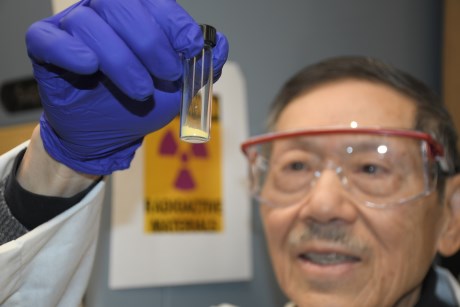First yellowcake from seawater for US team
Researchers have successfully used acrylic fibres to extract uranium from seawater in a trial conducted at Pacific Northwest National Laboratory (PNNL). The team say the technology, which uses inexpensive material, could be competitive with the costs of land-based uranium mining.
 |
| Yellowcake produced from uranium captured from seawater using LCW's modified yarn (Image: LCW) |
The material was developed by Idaho-based clean energy company LCW Supercritical Technologies with early support from PNNL through the US Department of Energy's Office of Nuclear Energy. Uranium in seawater is adsorbed onto a molecule that is chemically bound to the surface of the polymer fibre. The adsorbent properties are reversible, meaning that the uranium can be easily released and processed into yellowcake, and the polymer is durable and reusable.
Three separate month-long tests were carried out using seawater from Sequim Bay, next to PNNL's Marine Sciences Laboratory. Seawater was pumped through about a kilogram of fibre in conditions mimicking the open ocean. The uranium was then extracted, producing in total about five grams of uranium.
PNNL researcher Gary Gill described the achievement as a significant milestone, showing that the approach could eventually provide a commercially attractive option. "It might not sound like much, but it can really add up," he said.
Chien Wai, president of LCW, said the adsorbent material was inexpensive and could even be produced using waste yarn. The fibres also have the potential to be used in environmental clean-up and to extract other metals from seawater, such as vanadium.
LCW is now applying for further funding for a uranium extraction field demonstration, to be led by PNNL, in the Gulf of Mexico. The material performs much better in warmer water and extraction rates in the Gulf are expected to be three to five times higher, which would improve the economics further.
Seawater contains naturally occurring uranium at a concentration of about 0.003 parts per million. Although this concentration is very low - the average abundance of uranium in the Earth's crust is about 2.7 parts per million and ore grades are many times greater than that - the oceans are estimated to contain some 4 billion tonnes of the metal. The total uranium resources in land-based ores recoverable at costs of up to USD130 per kilogram stands at around 3.7 million tonnes, so the oceans could be an important resource of uranium if it can be recovered economically.
Research groups in China and Japan are also actively studying methods to extract uranium from seawater. China National Nuclear Corporation's Beijing Research Institute of Chemical Engineering and Metallurgy in 2017 signed an agreement with Saudi Arabia's King Abdulaziz City for Science and Technology to collaborate in research on extracting uranium from seawater, with Saudi and Chinese researchers to conduct a two-year investigation.
Researched and writtenby World Nuclear News